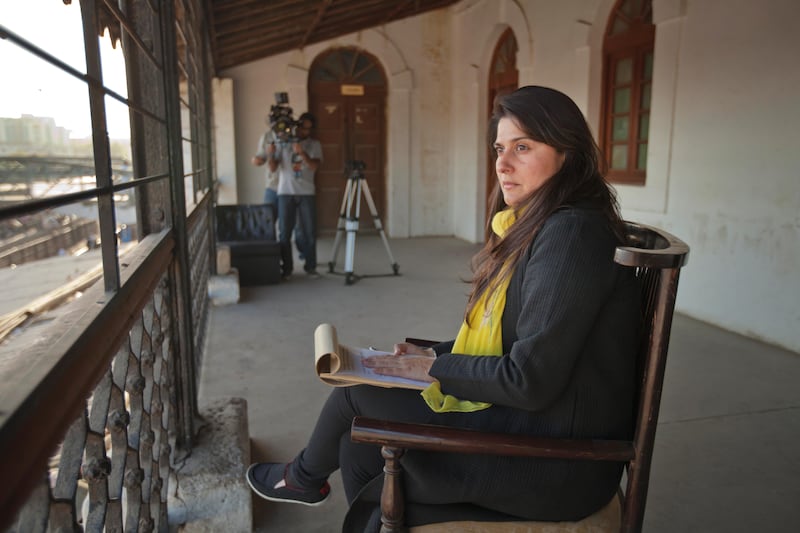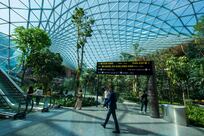“When we think about refugees and wars and displacement, it’s all too political today. It’s about ‘us’ and ‘them’; about ‘their’ way of life and how it’s going to impact ‘our’ way of life. It’s all about boundaries,” the award-winning Pakistani journalist, filmmaker and activist Sharmeen Obaid-Chinoy says.
The crossing of borders is central to the Academy Award- and Emmy- and Academy Award-winning director’s latest project, HOME1947, which received its world premiere on June 29 at The Lowry in Salford, Greater Manchester.
At a time when the number of people forcibly displaced worldwide has risen to an estimated 65.6 million according to the UN Refugee Agency, its highest level ever, HOME1947 could not be more timely. Yet and yet, as its title suggests, its immediate focus is not on the present but on the creation of Pakistan by partition, a 70-year-old event that still stands as one of the greatest migrations in human history.
The filmmaker’s first immersive installation, HOME1947 examines the human cost of the sub-division of the Indian subcontinent Subcontinent along religious lines, a process that began on 15 August 15, 1947, but still resonates today.
The creation of India and Pakistan saw Hindus and Sikhs cross new borders in one direction while Muslims travelled in the other amidst an unparalleled wave of murder, destruction and savage sectarian and sexual violence.
Within a few months, more than 10 million people were displaced, almost two2 million had died and an estimated 75,000 women were raped in an event that the Pakistani historian, Ayesha Jalal, has described as a defining moment that “continues to influence how the peoples and states of postcolonial South Asia envisage their past, present and future.”.
Part of this year’s Manchester International Festival, HOME1947 has been devised by Obaid-Chinoy, in collaboration with the United Kingdom UK and Pakistan-based producers Shanaz Gulzar, Aleeha Badat and Maheen Sadiq, the Karachi-based architect Ali Asghar Alavi and filmmaker Kamal Khan, the musician Ahsan Bari, and the Islamabad-based photographer Mobeen Ansari.
Despite the team effort, however, the installation remains a deeply personal endeavour for Obaid-Chinoy, whose previous projects have included A Girl in the River: The Price of Forgiveness (20152016) and Saving Face (2012), Academy Award- and Emmy-winning documentaries that addressed issues of honour killings and acid attacks in her native Pakistan.
“I’ve been thinking about partition for a long time, so when the festival approached me, I knew that it would be the ideal subject for my very first installation,” she tells me. “The thing about history and 1947 is that it’s always very political, but I grew up listening to my grandparents’ stories about the childhood homes they left behind, the smell of the earth when it rained, the fragrance of jasmine in the spring and the friendships they longed to rekindle, and so I wanted to make it very personal.”
The 48-metre-long, four4-part installation consists of a series of interiors that use archival footage, film, music, objects and 360-degree photographs of abandoned homes to pay tribute to the generation who lived through the rupture and violent legacy of Partition.
“We want people to feel like they are back in the Indian subcontinent in 1947. One day your home was your home, but the next it was in another, enemy country,” explains Obaid-Chinoy, who has even employed the unmistakable fragrance of night-flowering jasmine to evoke a sense of place.
Despite the scale of the tragedy and its role in the formation of contemporary Indian and Pakistani identities, Obaid-Chinoy has taken every effort to avoid issues of nationalism and religion.
“It’s not about who did what; it’s about the individual and their experience,” she explains. “So at no point in any of the installations do you know whether somebody is from the Indian or the Pakistani side of the border.”
The installation draws on oral testimonies and old photographs that the filmmaker has been collecting since 2007 when she founded the Citizen’s Archive of Pakistan, with the aim of recording Pakistan’s vernacular history, and Obaid-Chinoy has also collaborated with the Partition Museum in Amritsar to gain access to similar material from India.
The decision to commission Obaid-Chinoy was made last year in 2016 by the Manchester International Festival’s new artistic director, John McGrath, who spent months travelling the world searching for the right mix of artists who could create brand new works for the MIF’s extraordinary 18-day run.
These include the Pakistani musician Sanam Marvi, a master of the epic qawwali style of devotional singing, and the Indian playback singer Harshdeep Kaur, both of whom will perform on stage in Sangam 2017, an evening of Sufi music that will mark the installation’s opening.
“Rather than commissioning a documentary from Sharmeen, we gave her the opportunity to work in a different way,” says McGrath says. “But even though HOME1947 is talking about something that happened 70 years ago, it’s also talking about something that’s happening today, – how things like violence can erupt when the world changes and how we get back to humanity and the things that we value.”
After the festival, Obaid-Chinoy plans to take HOME1947 to a second venue in the UK, before touring Pakistan and India, and hopes that the installation will play a part in a new living history museum that she plans to open in Lahore next year in 2018.
“Anybody that has ever left home, been asked to leave home and not been able to return will find a resonance in HOME1947, because if you listen to these stories, you feel for people because you realise leaving your home changes you forever,” the filmmaker saysinsists. “Today, the world is in conflict and families are making the same journey, and I want people to go through the installation and think about every refugee who has to leave home and the feelings they carry with them.”





